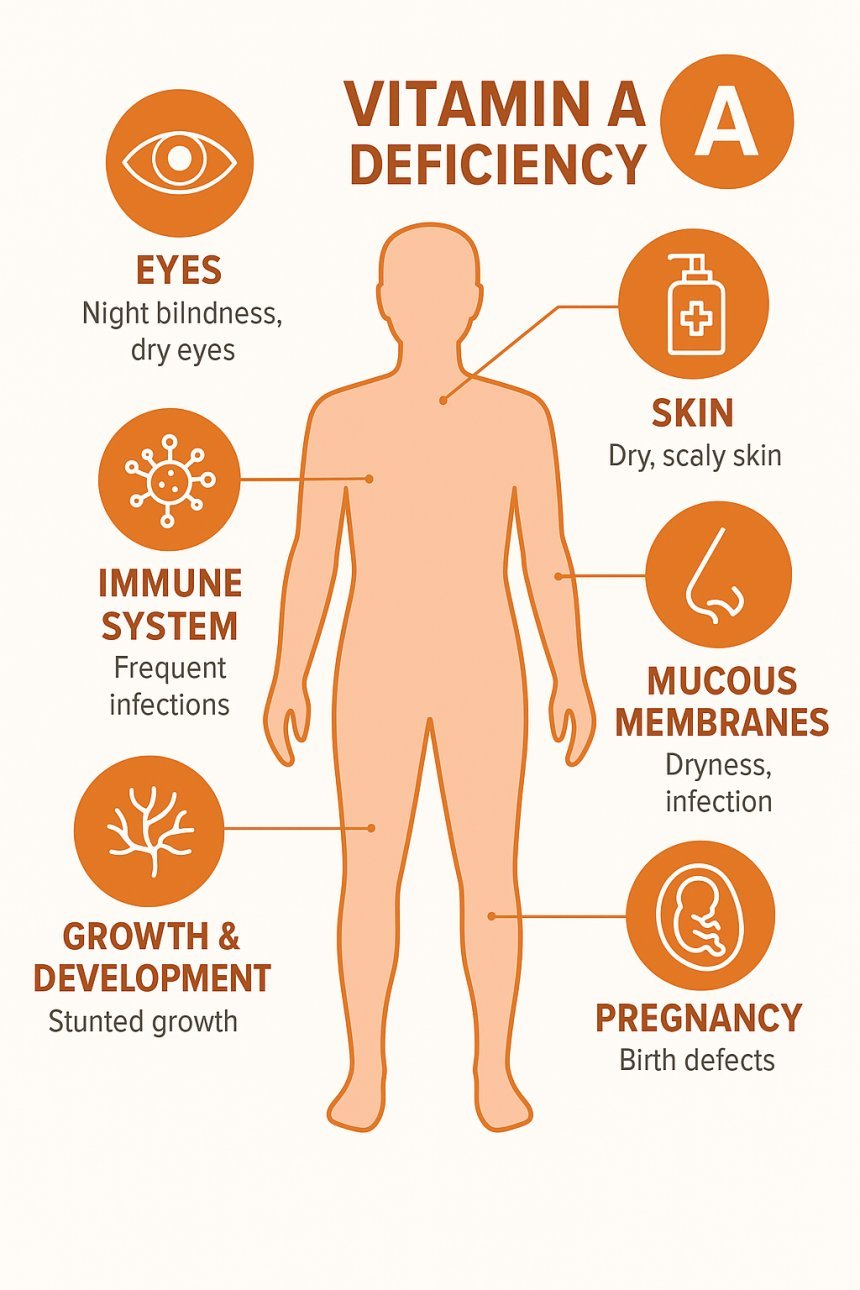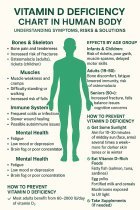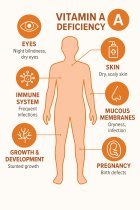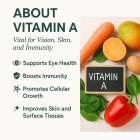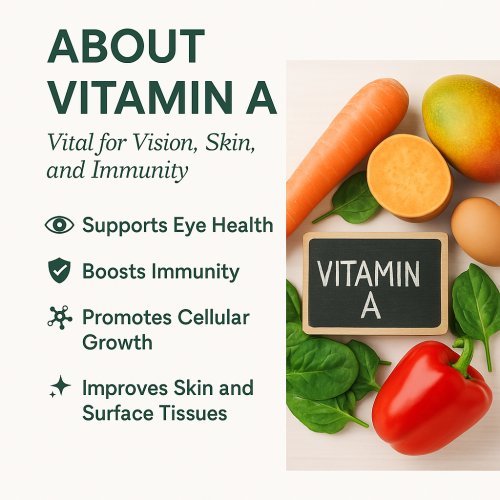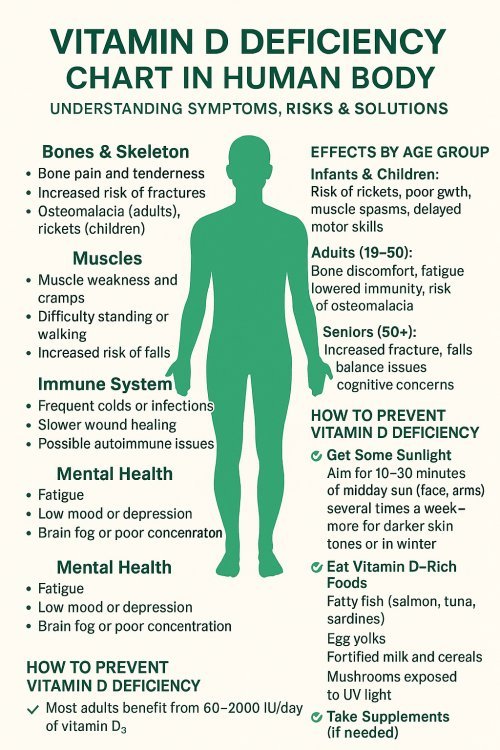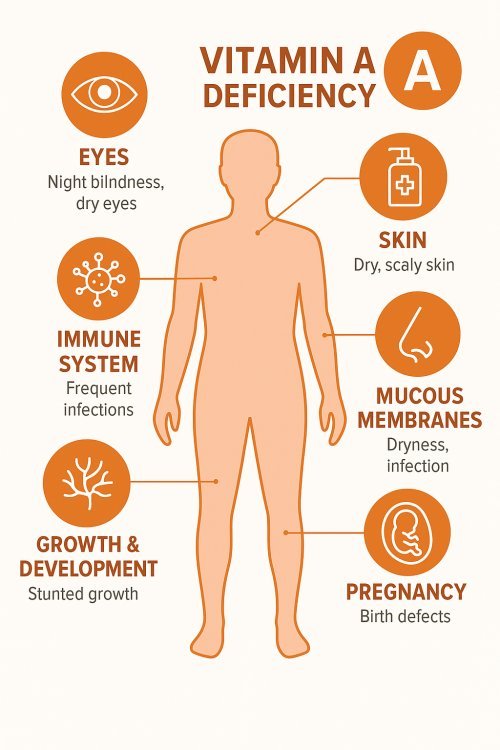Vitamin D deficiency chart in human body
Understanding Symptoms, Risks & Solutions. Vitamin D is a vital nutrient that supports bone strength, immune function, muscle performance, and mental well-being. While the body can produce vitamin D from sunlight, deficiency is still extremely common—especially in people with limited sun exposure, darker skin, or poor dietary intake.
Vitamin D Deficiency Chart in the Human Body
This chart outlines how vitamin D deficiency impacts various parts of the human body, along with its signs, age-specific effects, and prevention tips.
🧍♂️ Vitamin D Deficiency: Symptoms by Body System
| Body System | Symptoms / Effects |
|---|---|
| Bones & Skeleton | - Bone pain and tenderness- Increased risk of fractures- Osteomalacia (soft bones in adults)- Rickets in children (bowed legs, growth delay) |
| Muscles | - Muscle weakness and cramps- Difficulty standing or walking- Increased risk of falls (especially in seniors) |
| Immune System | - Frequent colds or infections- Slower wound healing- Possible autoimmune issues |
| Mental Health | - Fatigue- Low mood or depression- Brain fog or poor concentration |
| Cardiovascular | - Increased risk of high blood pressure- Possible heart health impact (research ongoing) |
| Teeth & Gums | - Delayed tooth eruption in children- Gum disease or tooth loss (adults) |
| General Wellness | - Low energy- Hair thinning- Poor sleep or recovery |
👶 Effects by Age Group
-
Infants & Children: Risk of rickets, poor growth, muscle spasms, delayed motor skills
-
Adults (19–50): Bone discomfort, fatigue, lowered immunity, risk of osteomalacia
-
Seniors (50+): Increased fractures, falls, balance issues, cognitive concerns
⚠️ Common Risk Factors
-
Limited sunlight exposure
-
Darker skin pigmentation
-
Aging (reduced skin synthesis)
-
Vegan or dairy-free diets
-
Obesity or weight-loss surgery
-
Digestive issues (e.g., Crohn’s, celiac)
-
Certain medications (steroids, anti-seizure drugs)
🦴 Consequences of Long-Term Deficiency
-
Rickets in children
-
Osteomalacia or osteoporosis in adults
-
Frequent falls and bone fractures
-
Weakened immune defense
-
Reduced quality of life
☀️ How to Prevent Vitamin D Deficiency
✅ Get Some Sunlight
Aim for 10–30 minutes of midday sun (face, arms) several times a week—more for darker skin tones or in winter.
✅ Eat Vitamin D–Rich Foods
-
Fatty fish (salmon, tuna, sardines)
-
Egg yolks
-
Fortified milk and cereals
-
Mushrooms exposed to UV light
✅ Take Supplements (if needed)
Most adults benefit from 600–2000 IU/day of vitamin D₃. Seniors or those with confirmed deficiency may need higher doses under doctor supervision.
🩺 When to Test for Deficiency
If you experience ongoing fatigue, bone pain, frequent infections, or are in a high-risk group, ask your healthcare provider for a simple blood test to check your vitamin D levels.
Stay well with the power of vitamin D.
Balance sunlight, food, and supplements to support your whole-body wellness from bones to brain.
Share
What's Your Reaction?
 Like
0
Like
0
 Dislike
0
Dislike
0
 Love
0
Love
0
 Funny
0
Funny
0
 Angry
0
Angry
0
 Sad
0
Sad
0
 Wow
0
Wow
0




